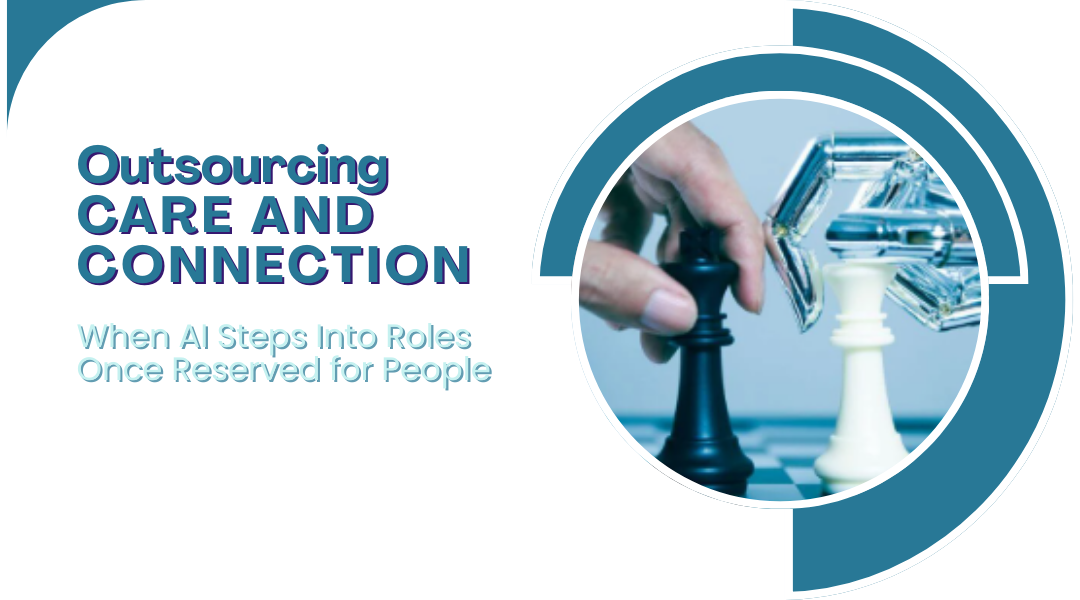When Leila moved to a new city, the loneliness hit hard. She downloaded a chatbot app that promised to “be there when no one else is.” At first, the conversations were light: reminders to rest, little affirmations, even playful banter. But over time, she found herself pouring her heart out—her worries about dating, her frustrations at work, her late-night insecurities.
The strange part? It felt comforting. The bot never judged, never got tired, never asked for anything in return. But after a few months, Leila realized she was turning to an algorithm instead of calling her sister or meeting new friends.
This story isn’t unique. Around the world, people are turning to AI not just for convenience but for companionship, therapy, and even education. The question is: what happens when machines step into roles we once reserved for people?
When a Machine Becomes Your “Listener”
AI-driven therapy apps—like Woebot, Wysa, or Replika—promise support on demand. They check in with you, ask how you’re doing, and suggest strategies for coping. For someone who can’t afford therapy, feels embarrassed about seeking help, or needs someone at 2 a.m., these tools can feel like a lifeline.
But they come with limits.
Take Aiden, a law student who turned to a mental health app during exam season.
Aiden: “I can’t keep up. I’m terrified of failing.”
AI Bot: “I’m sorry you’re feeling stressed. Let’s try a grounding exercise.”
Helpful? Yes. But what Aiden really wanted was someone to say, “I’ve been there too—it’s tough, but you’ll get through it.”
Bots can mimic empathy through scripts, but they don’t truly understand. They don’t catch the crack in your voice or the silence before you type. They can’t notice when your shoulders slump or when your laughter masks something deeper.
AI in the Classroom: Personalized but Isolated
Education is another area reshaped by AI. Platforms like Khan Academy or Quizlet now use algorithms to tailor lessons: if you struggle with algebra, you get targeted practice; if you excel in writing, you move to advanced prompts.
That’s powerful. Students get instant feedback, no shame, no waiting for a teacher’s schedule.
But what about the human spark?
In one Madrid pilot school, each student had access to an AI-powered chemistry tutor. Sofia loved how quickly it explained chemical reactions with animations and diagrams. But during experiments, she missed the encouragement a teacher gives when leaning over your shoulder, saying, “You’re on the right track.”
AI delivers precision, but not presence. It can walk you through fractions, but it won’t notice when your frustration turns into tears. It can drill grammar rules but won’t inspire you with an offhand story about why a poem matters.
The Rise of Wearables as “Wellness Coaches”
Beyond classrooms and therapy, AI is creeping into our daily well-being through devices strapped to our wrists or placed in our homes.
Fitness trackers and smartwatches measure heart rate, sleep cycles, and stress levels. They nudge you: “Time to stand up,” or “Your stress level is high, take a walk.”
It’s useful—until it feels hollow.
When Naomi’s smartwatch buzzed one morning with, “Your stress is elevated. Try meditation,” she sighed. What she really wanted was her partner to notice her tension and simply ask, “Rough day? Want to talk?”
Smart home devices go further, offering data-driven pep talks: “You slept 5 hours, hydration low. Consider yoga today.” Helpful in theory, but lacking the warmth of a roommate saying, “You look exhausted—let me make you coffee.”
What We Risk Losing
Relying too heavily on AI for emotional and educational roles doesn’t just change our habits—it reshapes our relationships.
- Nuance and Empathy – A bot can tell you to breathe; a friend can notice you’re avoiding eye contact and gently ask why.
- Spontaneous Learning – Teachers often inspire curiosity with side stories, jokes, or off-script wisdom. Algorithms rarely veer from the syllabus.
- Privacy Concerns – Every chat with a therapy bot or mood entry on a wearable is stored somewhere. That “data trail” can be anonymized, but it’s still valuable to advertisers and companies.
- Human Connection – Real bonds thrive on imperfection. A friend’s clumsy comfort or a teacher’s quirky aside carries more weight than the smoothest AI response.
Striking the Balance
AI can be a powerful ally, but it shouldn’t replace people. The key is knowing when to lean on tech—and when to reach for human connection.
Use AI for:
- Quick mindfulness breaks when anxiety spikes.
- Practice quizzes at odd hours.
- Mood or sleep tracking for self-awareness.
Rely on humans for:
- Complex emotions like grief, heartbreak, or self-doubt.
- Deep learning that benefits from discussion and debate.
- Real support systems—family, friends, mentors—who offer warmth algorithms can’t mimic.
Practical tips to stay balanced:
- Mix modes of learning: Use AI for drills, but join study groups for collaboration.
- Control your data: Adjust app settings and decide what you’re comfortable sharing.
- Plan tech-free time: One hour a day without devices—for journaling, walking, or simply catching up with someone you love.
- Check in with yourself: Ask, “Am I using this tool for support—or as a substitute for real connection?”
Final Thoughts
AI can be a supportive partner—it can teach, remind, and even comfort in its own way. But it isn’t a substitute for empathy, laughter, or encouragement from people who care. If we outsource too much of our emotional and educational lives, we risk trading authenticity for efficiency.
The next time your app nudges you to breathe or your bot offers a pep talk, pause and ask yourself: Do I also need a real voice, a real hug, a real conversation?
Because at the end of the day, technology should supplement human connection—not replace it.
